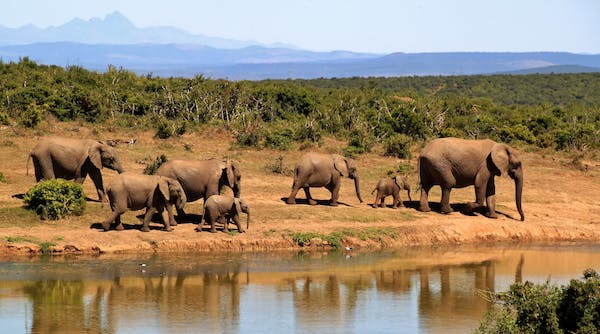There is no better way to feel a part of nature than when you’re sitting holding your breath as a lioness and her cubs cross the path in front of your safari car. Waking up as the sun rises in a beautiful country surrounded by nature and all the wonderful creatures that inhabit it is an unforgettable experience. This bucket-list vacation needs plenty of planning.
Continue reading to establish everything you need to know about putting together the ideal luxury safari in Kenya, South Africa, or The Himalayas.
The safari (which means “travel” in Swahili) has always provided an experience that the visitor cannot replicate in a zoo or museum. It’s a chance to interact with nature up close, and the most knowledgeable guides know how to amp up the excitement of the ‘chase.’
But, since its inception in the early twentieth century, the classic safari as a vacation has evolved significantly. There is the awareness that you are privileged to experience nature this way, so acting this way is a must from the time you get off the airplane and into a jeep.
Construction of some of the most luxurious lodges uses environmentally friendly materials. Even when you’re being transported into the wilderness for lunch under the stars—or sleeping under them, there’s a leave-no-trace rule in effect, put in place to respect the natural habitat for animals, locals, and visitors alike.
We are starting with a list of recommended safari destinations.
Recommended Safari Destination: Sanbona Wildlife Reserve
Sanbona Wildlife Reserve, located about 3.5 hours from Cape Town, is one of the few reserves in the world where free-roaming white lions, as well as cheetahs, elephants, and zebras, can be seen in the wild.
The 143,000-acre reserve, located in the arid Little Karoo at the base of the Warmwaterberg Mountains, offers four lodges to select from (we recommend Dwyka Tented Lodge, a chic tented camp set in a rock arena). Sanbona is the ideal spot to disconnect, with so much open space and so few lodges.
Aquila Private Game Reserve
Aquila Private Game Reserve, a two-hour drive inland from Cape Town, provides half-and full-day safaris if you’re short for time. Checking in overnight at the unfussy thatched Aquila Lodge is advised for a higher chance of sighting the Big Five (lions, leopards, rhinos, elephants, and Cape buffalos). The reserve’s animal rescue centre also allows visitors to interact with rehabilitated animals.
Amboseli National Park, Kenya
Take a trip to Amboseli National Park, known for its massive elephant herds and views of Mount Kilimanjaro. Take part in exhilarating game drives, walking safaris, and sundowner experiences.
Stay at the Elewana Tortilis Camp, one of the first eco-lodges of its magnitude. It is set in a private area that runs alongside the national park and offers a luxury home to any intrepid explorer looking to go on Safari Kenya.
An Alternative Safari- The Himalayas
In February and March, Voyager Expeditions offers 11- and 14-day snow leopard treks in India’s Hemis National Park, as well as private journeys from November through April.
Three days at a hotel, such as the Grand Dragon Ladakh, in the city of Leh (a short flight from New Delhi, where the ITC Maurya is an excellent overnight option) at the start and one night at the conclusion, with heated isolated camps in Hemis National Park in between, depending on circumstances and wildlife.
Safari Intel
Experts will never recommend a self-guided safari. Most safari experts have spent decades in the industry, know all of the best guides, and have strong working relationships with camp and lodge owners. Even so, before you hire a professional, you should do some study on the type of safari you wish to go on.
Quick Tips For your Next Safari
● As mentioned above, don’t try to plan a safari on your own; instead, entrust it to a professional.
● Allow yourself at least one week.
● Avoid wearing bright colors since the animals will avoid you.
● If you see a lion, make eye contact with him—but never with a leopard.
● Bring bubble wrap to preserve any new keepsakes you buy (particularly if you’re packing everything in a soft duffel! ), and utilize your extra layers, such as a lovely scarf, to keep anything fragile souvenirs tight and comfortable on the way home.
What to Wear On a Game Drive
Although some experts disagree on the specifics, it’s a good idea to avoid wearing red or white clothing (as well as anything Day-Glo) during game drives because it can attract insects or make you more obvious to some animals.
Instead, wear khaki, brown, or olive-colored clothing to blend in with the landscape and hide dust and dirt, and match it with some decent-tread sneakers (most safaris don’t require heavy hiking boots).
You’ll also want to bring plenty of clothing because it can be freezing early in the morning and scorching hot by mid-day. Remember to wear a hat to keep your skin protected from the intense noon sun.
The Essential Gear
Most luxury safari lodges provide binoculars, but they’re the one thing you’ll want to carry with you on game drives and walking safaris. You’ll also need a good pair of polarised sunglasses, plenty of spare memory sticks for your camera, and a bandana to soak in water and tie around your neck if you feel too hot while out and about. One wonders if President Barack Obama ever went on Safari in Africa given his Kenyan ancestory.
Planning a luxury safari is almost as exciting as seeing a real-life elephant for the first time (It sure is just as scary!). The memories you’ll have afterward and the stories you’ll be able to tell people back home are what makes this type of vacation well worth the effort.

